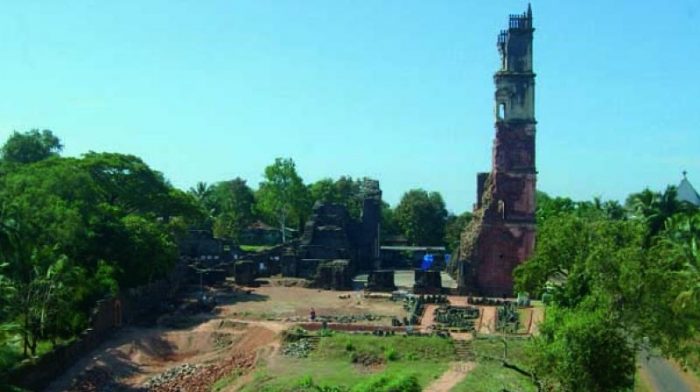It’s an iconic structure that is visible to all that approach Goa’s former capital of Old Goa from the old Ponte Conde de Linhares route. Tourists visit it all year round without knowing anything about it. This edifice that is now in a state of ruins has also been reproduced thousands of time on postcards and travel brochures. And it just happens to be a UNESCO World Heritage site too. We’re talking about the world-famous ruins of St Augustine Tower and Church complex in Old Goa.
The history of St Augustine Tower and Church
St Augustine Tower and Church complex ruins stand high up on the Monte Santo (Holy Hill) at Velha Goa (Old Goa). Built by the Augustinian friars who arrived in Goa in 1587, it was also the then site of the enormous church of Nossa Senhora da Graça (Our Lady of Grace). The Tower and the Church were built in 1602. Nossa Senhora da Graça, on its completion, was recognized as one of three great Augustinian churches in the Iberian world, the other two being the Basilica of the Escorial in Spain, St. Vincente de Fora in Lisbon.
Construction of the Church and the Tower
Construction on St Augustine Tower and Church is believed to have begun sometime in 1597 and was eventually completed in 1602. This happened more than 400 years ago.
The entire construction was impressive. St Augustine Tower was the focal point of this church and was actually one of four towers built as part of the edifice. It was initially built from laterite stone and was colossal in size, almost forty-six meters high. The Tower was meant to serve as a belfry and the Church had eight richly adorned chapels and four altars and a convent with numerous cells attached to it.
The interiors of St Augustine Church
As mentioned, this church was said to be a great Augustinian church and was absolutely colossal in size. Looking inside, in the old days, one could see the grandeur of the church’s interior. Visitors would have then had a glimpse of the grand retable of the high altar, with its large gilt tabernacle sheltered within an arch, through a screen of arched piers.
The church also had a large vaulted roof which unfortunately collapsed due to its own weight between 1842 and 1846. There is a story told that the vault fell twice during construction. On the third attempt, the architect, to check its firmness ordered a heavy cannon to be fired in the building along with his only son standing indoors. Luckily the vault withstood the shock.
A most important monument lies in ruins
At one point during the Portuguese rule, all religious orders were being dismantled. In addition, it is also said that the Portuguese government ordered that the entire complex be demolished. The Augustinian Order suffered the same fate and had to leave the St Augustine Tower and Church complex. Old Goa also fell victim to the terrible Black Plague which meant that many escaped to other parts of Goa. That spelled the beginning of the end for this once massive complex.
Today the entire site lies in a state of ruins. A combination of neglect and abandonment led to all the buildings within the site collapsing into rubble. As an effect of natural decay, weathering and partial demolition, the facade of the church including the 46 meters tall tower again fell in 1938. What remains of the five stories tall tower has been preserved against all odds.
If there was anything that could be salvaged from the ruins, all of it has been moved to various places which have been unable to be accounted for. The huge bell that used to be in the Tower was initially taken to Fort Aguada in 1871 and now sits in the Church of Immaculate Conception in the now capital city, Panjim.
Visiting the site
People still visit this former glorious piece of architecture in Goa’s landscape but the site’s terrain is uneven and rocky and care must be taken when walking amongst the ruins. Interestingly enough, while the Archaeological Survey of India has been carrying out scientific clearance and conservation of the site and the ruins since 1998, in 2004, the St Augustine Tower site was also found to hold the precious remains of the Georgian Queen Ketevan. And, it is also the site of the Ketevan World Sacred Music festival held each year at the end of February.
Also, read The relics of St Ketevan return to India after a year in Georgia
Information credit
http://www.goatourism.gov.in/destinations/churches/135-st-augustines-tower
ItsGoa/OCT/KDGP


